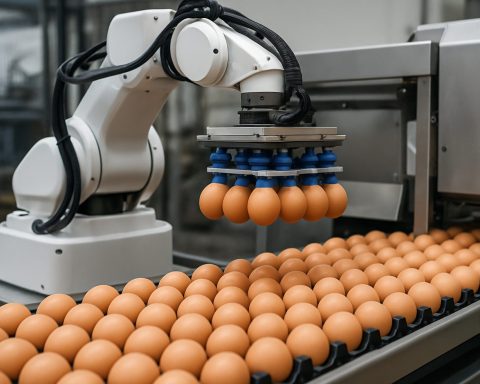- The intersection of nature and technology offers new insights for sustainable innovation.
- Biomimicry is essential, using nature’s patterns to inspire efficient human design.
- Structures mimicking termite mounds and silent owl flight enhance building and turbine tech.
- Urban farms and vertical gardens exemplify ecological balance in cityscapes.
- Technological advances should respect nature’s simplicity and ecological equilibrium.
- Innovation thrives by observing and integrating the wisdom found in natural ecosystems.
https://youtube.com/watch?v=7doe-L4JGz4
A gentle breeze rustles through the fleshy, green leaves of a forest glade. There, under the comforting embrace of ancient trees, the wonders of the natural world quietly unravel. But just beyond this picturesque scene, the digital age thrives, its lifeblood coursing through invisible networks and tangible devices. At the surprising intersection of these disparate realms—nature and technology—an enthralling synergy is coming to life.
In today’s rapidly advancing world, the fusion of biomimicry and cutting-edge technology offers a new lens through which to view our surroundings. Biomimicry, the practice of observing and emulating nature’s time-tested patterns and strategies, has begun to play a critical role in sustainable innovation. Engineers and scientists are turning towards the intricate genius of ecosystems and creatures large and small, striving to duplicate their elegant solutions in human design.
The towering city skyscrapers aren’t merely emulating nature’s aesthetic beauty but also its functional wisdom. Structures inspired by termite mounds regulate their temperature with remarkable efficiency, thanks to a deep understanding of natural ventilation processes. Similarly, the swift, silent flight of an owl has spurred advancements in wind turbine technology, aiming to create energy solutions as silent as they are eco-friendly.
As our cities continue to expand, finding harmony between urban development and ecological balance becomes increasingly critical. An emerging frontier is the development of urban farms and vertical gardens, which mimic forest ecosystems by recycling water, nutrients, and even carbon dioxide to maximize productivity in condensed spaces.
Yet, despite the excitement of technological breakthroughs, it’s crucial to remember the inherent wisdom of simplicity found in nature. While our increasingly connected world strives to innovate, it should also tread lightly, employing technologies that respect the delicate equilibrium of the planet.
The tangible harmony of nature and technology serves as a poignant reminder of how innovation can flourish when we move beyond traditional thinking. By stepping back and observing the natural world around us, we can forge paths towards sustainable futures that were once mere whispers carried by the wind.
As we continue to chase technological marvels, this profound connection with nature underlines one key point: the greatest inspiration often lies not beneath microscopes, but in the lush tapestry spread beneath the expansive sky. This silent symphony of innovation and nature calls to our collective consciousness—urging us to embrace and preserve the very wonders that have been fueling our imaginations and progress all along.
Nature Meets Tech: How Biomimicry Is Shaping Our Future
The Intersection of Biomimicry and Technology
In today’s interconnected world, the fusion of biomimicry—a practice where design and innovation draw inspiration from the natural world—and technology is reshaping various industries. This approach not only offers sustainable solutions but also casts a spotlight on the profound wisdom inherent in nature’s designs.
Real-World Use Cases of Biomimicry
1. Energy-Efficient Architecture:
– The Eastgate Centre in Harare, Zimbabwe, is a prime example where biomimicry plays a role in architecture. Inspired by termite mounds which maintain constant temperatures, this building uses similar ventilation strategies to reduce energy use significantly.
2. Transportation Advances:
– The famous Japanese Shinkansen bullet train’s nose design is modeled after a kingfisher’s beak, allowing it to travel quietly and efficiently. This nature-inspired design has reduced air resistance and increased speed.
3. Robotic Engineering:
– Engineers are designing robots mimicking animal characteristics for improved mobility and efficiency. Boston Dynamics’ robotic dog, Spot, showcases such advancements. Nature serves as a crucial guide in developing robots that navigate diverse environments seamlessly.
How-To Steps for Implementing Biomimetic Principles
1. Observation: Spend significant time observing and understanding natural processes and structures.
2. Identification: Identify specific patterns or strategies in nature that solve particular problems.
3. Emulation: Develop designs or systems that incorporate these natural strategies.
4. Testing: Prototyping and testing are critical to ensure that the biomimetic solutions are viable and efficient.
5. Integration: Implement these solutions into society while ensuring minimal ecological disruption.
Industry Trends and Insights
– Market Forecasts: With increasing environmental concerns, the demand for biomimetic designs is expected to grow. The biomimetic market is set to experience a significant upswing, particularly in architecture, agriculture, and renewable energy sectors.
– Sustainability and Innovations: As sustainability becomes integral, industries are expected to continue investing in biomimetic research and development. This trend aligns with global goals for sustainable environmental practices.
Controversies and Limitations
While the benefits of biomimicry are profound, there are controversies regarding the intellectual property rights of these designs. Nature-inspired solutions often lack clear ownership, leading to ethical and legal debates.
Pros and Cons Overview
– Pros:
– Energy efficiency
– Innovative solutions to complex problems
– Sustainable environmental practices
– Cons:
– High initial research costs
– Intellectual property challenges
– Potential ecological disruption if not carefully implemented
Actionable Recommendations
– Embrace Versatility: Encourage flexible thinking by looking at traditional problems through a biomimetic lens. Collaborate across disciplines to foster holistic solutions.
– Prioritize Education: Invest in education and training to build expertise in biomimetic design principles, offering courses that blend biology, art, and technology.
– Foster Innovation: Support research and development initiatives that seek to translate natural efficiencies into technology applications.
For further insights, explore more at Biomimicry Institute.
By harnessing the time-tested strategies of nature, we hold the potential to inspire a future where technology not only coexists with but actively enhances the natural world. This symbiosis is not merely beneficial; it is essential for a sustainable tomorrow.







